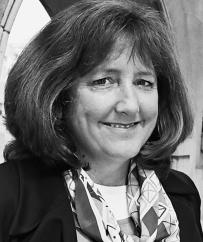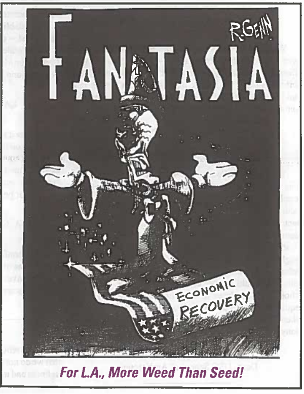For this special issue of The Planning Report focusing on how to “rebuild” Los Angeles, we asked top community leaders the question, “Assuming economic forces converge to rebuild Los Angeles, what kind of Los Angeles should we be rebuilding?”

Linda Dishman
"In the early 1960s, Jane Jacobs described a city of small blocks, mixed uses, varied building types and day and night street life — the antithesis of the typical government-sponsored “project,” and not very much like much of Los Angeles. The result was a community very much owned, policed and cared for by its people. That is the Los Angeles we need to build — not rebuild."—Linda Dishman
We must build a Los Angeles that feeds, houses, educates and employs its people — all of its people. But we should also build a Los Angeles that understands its peoples’ need for community and contact — so let us build plazas, fountains, parkways, and gateways. And finally, let us build a Los Angeles that celebrates what is unique to this region — palms and flowers and trees, in all their California variety and abundance.
Ira Yellin The Yellin Company
We should insist upon a higher quality of development — utilizing the creative talents of our artists, architects, and design planners, and reflecting the rich cultural diversity of the community.
Joel Wachs L.A. City Council, 2nd District
The psychic rebuilding is more important than the physical. People need confidence about L.A.’s future. If jobs, education and equality are the building blocks of our planning, the land-use considerations will be addressed in logical sequence.
Roderick Hamilton MCA Development Company
City leaders should concentrate their efforts on the goals of creating entry-level jobs, business opportunities, and affordable housing for people who have been outsiders to the economic system. New commercial projects should emphasize flexible, affordable spaces which would locate less experienced entrepreneurs close to more seasoned business owners who would advise them and help attract compatible customers.
On sites of burned-out buildings, new housing should be encouraged in mixed-use projects which would provide housing units on floors above ground floor pedestrian-oriented retail uses, thus physically reinforcing the residents’ sense of identification with neighborhood business.
Michael Woo L.A. City Councilman, 13th District
We must rebuild a Los Angeles in which individuals have a stake in their community — through ownership of affordable housing, jobs in local businesses, and neighborhood pride. We must plan more than streets and buildings — we must build a sense of local identity and community spaces for people.
Clare Bronowski Christensen, White, Miller, Fink and Jacobs
The journey is about being someone, somewhere! Let’s start with neighborhood-making: affordable housing; accessible public institutions; places of business, employment and services; transportation and mobility; and a distinctive setting (somewhere rather than anywhere). We require policies to redirect public improvements and the location of public institutions as strategic catalysts for neighborhood-making. We require shops and stores on pedestrian-oriented rather than drive-by streets, local town halls with multi-service centers and libraries, enhanced school sites as places of learning and community. We require neighborhoods where you can be someone, somewhere constructively. We require such neighborhoods, of many different flavors, throughout the region.
Robert S. Harris Dean, USC School of Architecture
Los Angeles’ past — as expressed in its cultural and historic architectural resources — greatly contributes to making the city a more livable, human place. As Los Angeles rebuilds, existing architectural resources must be preserved and revitalized to connect the past with the present and new construction must provide a confident, proud link of the present to the future.
Linda Dishman Executive Director, Los Angeles Conservancy
In the early 1960s, Jane Jacobs described a city of small blocks, mixed uses, varied building types and day and night street life — the antithesis of the typical government-sponsored “project,” and not very much like much of Los Angeles. The result was a community very much owned, policed and cared for by its people. That is the Los Angeles we need to build — not rebuild
Tom Muller Partner, O’ Melveny and Myers
Don’t just “rebuild,” but plan a new city:
-
Let’s put the Planning Department and not the Transportation Department in charge of planning (no more concrete; let’s give pedestrians a chance)
-
Establish citywide design criteria (good for all concerned — developers, homeowners groups, etc.)
-
Provide incentives (not penalties as dictated by the Congestion Management Program) to developers to build at and around transit stations and along transit corridors..
Nick Patsaouras LACTC and RTD Board Member
We need to build a Los Angeles that places a greater emphasis on its people. The gap between the haves and have-nots have brought this city to a painful crossroads, and we cannot move forward without bridging the differences that separate communities and people. We must rebuild our people.
Mike Hernandez L.A. City Councilmember, First District
New confidence, rather than concrete, must be the cornerstone of future Los Angeles. Confidence by business that investment is welcome. Confidence by citizens that streets are safe.
Gary Morris GLM Associates
As we rebuild South-Central Los Angeles, it is critical that we do not simply rush to restore the same patterns of ugliness and misdirected land use that existed before the civil unrest. Placing a priority on aesthetics in design and planning could play a major role in restoring morale.
We must also ensure that local communities are involved in determining what kinds of establishments are to be rebuilt — and finally heed the angry opposition to the horrendous over-concentration of liquor stores.
Rita Walters L.A. City Councilmember, Ninth District
We need a two-pronged strategy to rebuild Los Angeles. The first is to help rebuild those buildings and businesses burned and looted, quickly and without controversy, utilizing maximum available public and private resources. No resources should be diverted to other purposes unless this mission is first accomplished.
The second is to help rebuilding community leadership resources in Los Angeles in such a way that this kind of riot would not be repeated. For us to live and work together in this city each ethinc group must:
-
Stop confrontational and adversarial posturing, blaming others for their plight
-
Start listening to what others are saying and empathizing with their perspectives. “Empathy” does not necessarily mean agreement, but it means that you are placing the perspective of others equal to yours.
Ki Suh Park Managing Partner, Gruen Associates
A world-classless city. A city where the “have nots” who come from every corner of the globe have the opportunity to gain a productive job, decent housing, accessible transportation, and influence over their governmental institutions. A city whose built environment respects the diversity of its inhabitants and encourages the unity of its many communities.
Gerry Hertzberg LACTC Commissioner
- Log in to post comments




